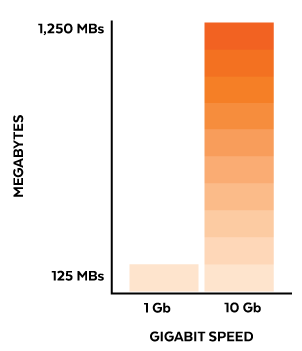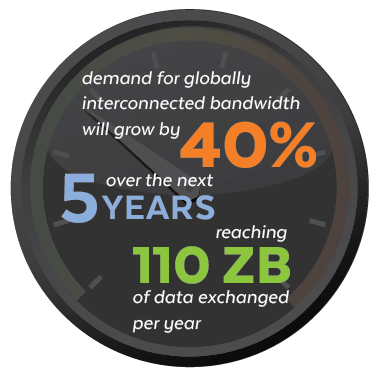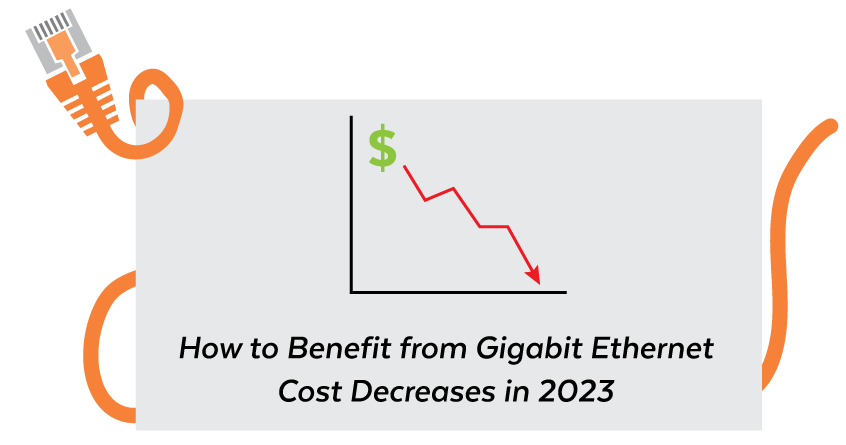Who doesn’t want more for less? With the potential for a global recession looming, businesses everywhere are focusing on reducing costs to maximize their cash flow. Many companies are reducing staff or limiting product lines in order to cut expenses. They are putting technology upgrades on hold. However, as gigabit Ethernet (GbE) costs decrease, businesses may want to consider improving their network performance as another way to increase productivity and cut costs.
What is GbE?
Gigabit (Gb) Ethernet (E) uses standard Ethernet technology to send data at a rate of 1,000 Mbps or 1 billion bits per second. Most organizations use 10 to 100 Mbps Ethernet connections for their wired local area networks (LANs), but now, more companies are moving to a GbE for their network backbone.
Although the technology was available as early as 1999, its usage was limited until 2010, when internet demands increased. GbE is faster than wireless connections because of its reliability and its ability to carry a signal up to 43 feet.
Existing Cat5e and Cat6a cables can support faster transmission speeds when configured correctly. As a result, businesses may leave LANs in place and use the GbE backbone to connect to high-speed (gigabit) internet. GbE operates at ten times the speed of a megabit connection. With increased video use, companies need higher speeds to eliminate the latency that often comes with lower transmission rates.
How Fast is a GbE Network?
One gigabit equals 125 megabytes, which means a gigabit network can transfer 125 megabytes per second. Network providers typically cap their speeds at 10 Gbps, but some providers may offer higher speeds.
Actual network performance depends on the devices transmitting the data. For example, hubs, switches, and routers must support gigabit speeds. Poor cabling or slow network controllers can hamper transmission speeds. Memory, read/write speeds, and other services can decrease network performance.
How is GbE Used?
Anyone sending or receiving visual data can benefit from GbE. Images are data-intensive, requiring high speeds for efficient data transfer. It’s not just the consumers, who stream video games or binge-watch movies, that need these speeds. The creators of those games and movies also need faster speeds for project collaboration.
With more people working remotely, large data files can take hours to transfer if bandwidth is limited. How many times have employees joked that they were taking a coffee break while a file downloaded? How much does productivity decline when network speeds are too slow?
If companies want to improve their bottom lines, they need to consider how slow network speeds hamper workflow. They should also consider how combining power over Ethernet (PoE) with GbE can reduce costs and improve operations in areas such as security, edge computing, and sustainability.
Security
Physical security is as much a threat as cybersecurity to organizations. Limiting access to facilities and monitoring property perimeters are all part of keeping a business secure. These protective factors can also be costly.
PoE technology can support electronic access control systems as well as security cameras to reduce power costs. With GbE, transfer speeds can occur in real time without impacting the network overall. Employees can continue to work while security has access to low-latency video for clearer images.
Edge Computing
The Global Interconnection Index (GXI) 2023 found that the edge is growing twice as fast as an enterprise core. This growth puts a strain on network performance if the infrastructure has not increased its capabilities beyond the 10/100 Mbps network. Increasing data transmission rates does not increase power requirements, which means the power-to-data speed ratio will be lower at higher transfer rates.
With more mission-critical devices being deployed at the edge, transmission delays may have unexpected consequences. Large interconnected healthcare systems need to transmit information quickly. When a patient arrives at one location, healthcare professionals need access to treatments across the system. Pulling data from locations at the edge of the system cannot wait while network traffic clears. In an emergency, milliseconds matter.
Sustainability
GbE and PoE may not be the first technologies that come to mind when we discuss sustainability. However, reducing power consumption has a direct impact on the environment. Deploying PoE devices throughout a facility reduces wiring and consolidates power requirements. With more data flowing through cables, the power-to-data ratio is less.
Are Faster Ethernet Speeds Necessary?
Faster connectivity may not be an absolute necessity today, but it will be required to stay competitive in the near future. The GXI 2023 study found that the demand for globally interconnected bandwidth will grow by 40% over the next five years, reaching 110 zettabytes of data exchanged per year. That means organizations of all sizes must find a way to efficiently process the ever-increasing data flow.
Gigabit Ethernet with PoE offers companies a cost-effective path to remaining competitive. This combination of technology offers:
- Increased Reliability: As fiber optic cables replace copper wiring, connections will become more durable.
- Faster Transfer Speeds: Companies are already experimenting with 800 GbE networks.
- Lower Latency: Users can expect latency rates reduced by between five and 20 milliseconds.
- Smoother Streaming: Streaming 4k content at high frame rates becomes possible.
With the growing deployment of IoT, organizations must process data from the edge while delivering uninterrupted services to their distributed workforce. Existing Mbps networks will struggle to deliver a quality experience as data requirements grow.
Who Benefits from a Cost of GbE Decrease?
Everyone benefits from lower energy per gigabit usage. Large data centers can reduce energy costs without sacrificing performance. Less energy not only reduces operating costs but also lowers carbon footprints. Employees become more productive and less frustrated as applications load quickly, and data transfers no longer take minutes.
Combining PoE with GbE lowers the cost of deploying and maintaining Internet of Things (IoT) devices. PoE can reduce electrical installation costs by delivering power and data through a single connection. With greater bandwidth, more IoT devices can be deployed without impacting the network. With more data points, organizations can gain insights that will fuel further growth.
Versa Technology, Inc. offers a range of PoE products that can support gigabit Ethernet technology. If you’re looking to deploy GbE, contact us to discuss your equipment needs.

